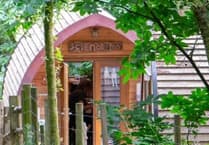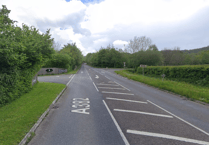BATTLE plans are being drawn up by an eco-group of 21 woodlanders under threat of eviction from their community project at a 32-acre beauty spot outside Moretonhampstead.
The national park authority is seeking to have the Wray Valley’s ‘experimental living’ settlement cleared after refusing planning permission for the site to be made permanent.
The occupants – Steward Community Woodland (SCW) – were given a year to move on by the authority last June after spending the last 15 years among the trees.
The unwanted residents of 12 adults and nine children have since appealed against the planning refusal and the Enforcement Notice giving them just a few more months before they have to quit the location.
A public inquiry will now be held at the authority’s base outside Bovey Tracey, where the two sides will slog it out at a three-day hearing which gets underway on April 26.
inspiring
SCW is trying to raise £38,000 to finance its legal scrap with the authority. So far they have collected £23,000.
SCW supporter Aaron Custance said this week: ‘Their evolving project has attracted visitors from around the world, inspiring thousands of others to make positive changes in their own lives, perhaps even make it “off grid” like the woodlanders themselves.’
He added: ‘Temporary planning permission was won twice on appeal for the group’s simple self-built, cosy structures.
‘But despite enormous local support – including that of the parish council – Dartmoor National Park Authority (DNPA) quickly rejected their application for permanent permission.’
Among those lending their support to the group is a local film company which has produced a ‘crowd-funding’ video for the site ‘indiegogo.’
The public launch of the film – and the crowd-funding campaign – was at The Horse in Moretonhampstead which was packed full with well-wishers.
It was on April 10 last year that the Dartmoor authority’s development management committee ‘took the difficult decision’ to refuse permanent planning permission for a ‘low impact’ residential development at Steward Wood in the Wray Valley.
The reason for refusal was the perceived harmful effect on the character and appearance of the national park which was contrary to the National Planning Policy Framework and a number of DNPA policies.
Two previous approvals for temporary permission granted by the Planning Inspectorate expired in June 2014.
The park authority appointed independent consultants to assess the impact of the existing development within the woodland, with particular attention paid to woodland management and permaculture.
In assessing the application for permanent residential use, the consultants found there was no clear evidence that the experiment had been successful and that the development was truly sustainable in the long term.
PROTECTED
A spokesman for the authority said: ‘The report from the independent woodland management expert highlighted several concerns around the way the woodland had been managed.
‘Concern was expressed about how an outbreak of larch disease would be managed in the future. The consequence of this disease is that all larch trees are felled, meaning that the visual impact of the development could be substantial if large areas of larch had to be removed.
‘Another area of concern was the lack of consideration for European Protected Species, three of which are present either on the site or within the area – namely otters, hazel dormice and woodland bats, particularly the Greater Horseshoe Bat.’
The woodland management expert said: ‘I can see no real justification for any residential property on site, regardless of whatever form of land management one might favour or woodland enterprise.’
The experimental approach to permaculture was questioned in the report, which highlighted the lack of evaluation as to how successful it had been.
CONFUSED
The report said: ‘The woodlands land use by the community has been experimental and lacks coordinated and robust evaluation of the impact to date and any accrued benefits. The application requests additional development to be considered, raising the suggested number of people who will potentially live, work and enjoy the recreational use of the site. This suggested increase of community and the unknown impact is of concern from a sustainable land use perspective as the site’s current use is confused.’
Members of the development and management committee were aware of the impact of the decision to refuse permission on the people living on the site and on their human rights.
The enforcement action subsequently taken in June 2015 allowed 12 months for compliance in order to allow sufficient time for relocation.
The ‘bottom line’ was said to be the protection of Dartmoor National Park and the need to ensure that countryside development was genuinely essential and sustainable over the longer term.
The authority spokesman confirmed that the decision of the authority – to refuse planning permission and to take enforcement action against the unauthorised development on the land – was the subject of appeals.




